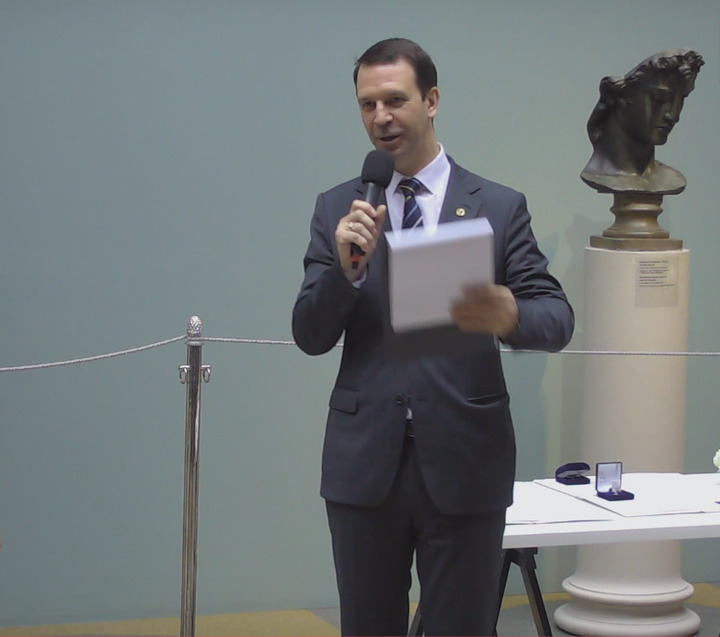Academician Oganesyan spoke about the dispute between Western and Russian scientists over element 118
[ad_1]
Let us remind you who Yuri Tsolakovich Oganesyan is. This is a Soviet and Russian scientist, a specialist in the field of experimental nuclear physics, scientific director of the Laboratory of Nuclear Reactions named after. G. N. Flerov at the Joint Institute for Nuclear Research (JINR) in Dubna.
At JINR, under his leadership, elements 104, 105 and 106 of the periodic table were synthesized, as well as new elements – from 113 to 118. The last, 118th element was named after its discoverer – oganesson (Og). Thus, oganesson became the second element named after a living person. The first, seaborgium, was named after the American Berkeley physicist Glenn Seaborg.
Today, oganesson is the heaviest and last chemical element on the Periodic Table.
For more than one year, the Russian Academy of Sciences has been emphasizing Oganesyan’s enormous contribution not only to domestic but also to world science. The academician was nominated for the Nobel Prize more than once, but in vain.
Last year, celebrating his 90th birthday on April 14, Yuri Tsolakovich, who had not yet received a high award, rose above the Nobel committee, which is often guided not by the scientific merits of the candidates, but by the political situation. Oganesyan approved a personal bonus, basing it on the potential of his bonus 20 million rubles, which he received from one of the Russian banks.
At the ceremony, JINR Director Grigory Trubnikov said that the prize established by Yuri Oganesyan and JINR has an international statute. The OGANESSON Prize will be awarded annually for significant achievements in theoretical and experimental research in the fields of physics, chemistry, biology and applied problems, as well as for creative activities in the field of education and popularization of science.

The prize jury, chaired by Academician Alexander Sergeev, named the first four laureates.
The first recipient of the OGANESSON 2023 Prize was Ana Maria Cetto Cramis, a professor of physics at the University of Mexico, “for her outstanding scientific work in the field of quantum mechanics and theoretical physics and for her enormous personal contribution to strengthening global scientific cooperation.”
The second laureate was announced as the artistic director of the Moscow Musical Theater, cultural figure Mikhail Shvydkoy. He is also the special representative of the President of the Russian Federation for international cultural cooperation, and a doctor of art history.
Two more awards were received by Valeria Pershina, a professor at the Institute of Heavy Ions in Darmstadt (Germany) and the head of the scientific and experimental accelerator complex of the Laboratory of Nuclear Reactions named after. Flerov JINR Vasily Semin. “The leader of the accelerator group,” is how the director of the institute, Academician of the Russian Academy of Sciences Grigory Trubnikov introduced him.
“Now science is losing its popularity, but events such as a new prize always highlight interest,” said Semin, who has achieved outstanding results over a 10-year career.

The ceremony was concluded by Yuri Oganesyan himself, as always, wisely, witty, and philosophically. I started my speech like this: “I’ll start in Chekhov’s way: “Lord, how good!” He said that it was difficult to choose the best of the best, especially the first time. I thanked Alexander Sergeev, who helped select the first laureates. “Of course, these were not random people… Although anyone can receive the prize,” Ogonesyan said. – I would like to say that our laureates are outstanding. This fragile woman, Ana Maria Cetto Kramis, wrote a popular book entitled: “Light in Nature and in the Laboratory.” I am very pleased that this prize is not only for science, but also for the popularization of science. <...>As for Valeria (Pershina), she belongs to the stars of the first magnitude, and in the science related to quantum electrodynamics, which was studied by great people. And among these stars there are two constellations. One constellation is America, New Zealand and Germany, maybe Japan, and the second constellation is St. Petersburg, Switzerland, Tel Aviv – our Russian-speaking people. These two constellations did not agree on one element – the 118th – oganesson. The badge (which was given to the laureates) will remind Valeria that the question of who is right has not yet been resolved. Some say that oganesson will not be a noble gas, because the relativistic effect intervenes, the theory of relativity intervenes and slightly disrupts the structure of electrons. Our people say: nothing of the sort, everything will be as it should be, and 94 percent of it will be noble gas.” Further, Yuri Tsolakovich said that the experiments that he and Vasily Semin will conduct in their laboratory should put an end to this dispute. “When they give a prize to young people, they say: he has everything ahead of him. But Vasily already has a lot behind him. Together with his teacher, he created a new installation, an accelerator that is 15 times superior to all accelerators in the world. This machine has been running for five years now. And maybe we owe a lot of our success to this accelerator.”
[ad_2]
Source link








